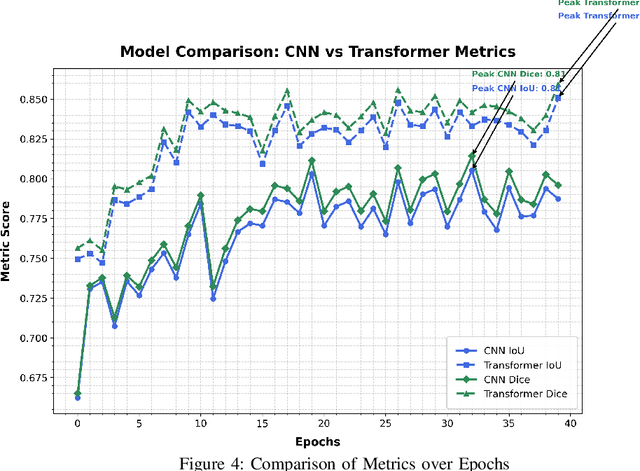Ashim Dahal
Embedding Shift Dissection on CLIP: Effects of Augmentations on VLM's Representation Learning
Mar 30, 2025Abstract:Understanding the representation shift on Vision Language Models like CLIP under different augmentations provides valuable insights on Mechanistic Interpretability. In this study, we show the shift on CLIP's embeddings on 9 common augmentation techniques: noise, blur, color jitter, scale and rotate, flip, elastic and perspective transforms, random brightness and contrast, and coarse dropout of pixel blocks. We scrutinize the embedding shifts under similarity on attention map, patch, edge, detail preservation, cosine similarity, L2 distance, pairwise distance and dendrogram clusters and provide qualitative analysis on sample images. Our findings suggest certain augmentations like noise, perspective transform and shift scaling have higher degree of drastic impact on embedding shift. This study provides a concrete foundation for future work on VLM's robustness for mechanical interpretation and adversarial data defense.
Analysis of Zero Day Attack Detection Using MLP and XAI
Jan 28, 2025Abstract:Any exploit taking advantage of zero-day is called a zero-day attack. Previous research and social media trends show a massive demand for research in zero-day attack detection. This paper analyzes Machine Learning (ML) and Deep Learning (DL) based approaches to create Intrusion Detection Systems (IDS) and scrutinizing them using Explainable AI (XAI) by training an explainer based on randomly sampled data from the testing set. The focus is on using the KDD99 dataset, which has the most research done among all the datasets for detecting zero-day attacks. The paper aims to synthesize the dataset to have fewer classes for multi-class classification, test ML and DL approaches on pattern recognition, establish the robustness and dependability of the model, and establish the interpretability and scalability of the model. We evaluated the performance of four multilayer perceptron (MLP) trained on the KDD99 dataset, including baseline ML models, weighted ML models, truncated ML models, and weighted truncated ML models. Our results demonstrate that the truncated ML model achieves the highest accuracy (99.62%), precision, and recall, while weighted truncated ML model shows lower accuracy (97.26%) but better class representation (less bias) among all the classes with improved unweighted recall score. We also used Shapely Additive exPlanations (SHAP) to train explainer for our truncated models to check for feature importance among the two weighted and unweighted models.
Efficiency Bottlenecks of Convolutional Kolmogorov-Arnold Networks: A Comprehensive Scrutiny with ImageNet, AlexNet, LeNet and Tabular Classification
Jan 27, 2025Abstract:Algorithmic level developments like Convolutional Neural Networks, transformers, attention mechanism, Retrieval Augmented Generation and so on have changed Artificial Intelligence. Recent such development was observed by Kolmogorov-Arnold Networks that suggested to challenge the fundamental concept of a Neural Network, thus change Multilayer Perceptron, and Convolutional Neural Networks. They received a good reception in terms of scientific modeling, yet had some drawbacks in terms of efficiency. In this paper, we train Convolutional Kolmogorov Arnold Networks (CKANs) with the ImageNet-1k dataset with 1.3 million images, MNIST dataset with 60k images and a tabular biological science related MoA dataset and test the promise of CKANs in terms of FLOPS, Inference Time, number of trainable parameters and training time against the accuracy, precision, recall and f-1 score they produce against the standard industry practice on CNN models. We show that the CKANs perform fair yet slower than CNNs in small size dataset like MoA and MNIST but are not nearly comparable as the dataset gets larger and more complex like the ImageNet. The code implementation of this paper can be found on the link: \href{https://github.com/ashimdahal/Study-of-Convolutional-Kolmogorov-Arnold-networks}{https://github.com/ashimdahal/Study-of-Convolutional-Kolmogorov-Arnold-networks}
Heuristical Comparison of Vision Transformers Against Convolutional Neural Networks for Semantic Segmentation on Remote Sensing Imagery
Nov 14, 2024



Abstract:Vision Transformers (ViT) have recently brought a new wave of research in the field of computer vision. These models have done particularly well in the field of image classification and segmentation. Research on semantic and instance segmentation has emerged to accelerate with the inception of the new architecture, with over 80\% of the top 20 benchmarks for the iSAID dataset being either based on the ViT architecture or the attention mechanism behind its success. This paper focuses on the heuristic comparison of three key factors of using (or not using) ViT for semantic segmentation of remote sensing aerial images on the iSAID. The experimental results observed during the course of the research were under the scrutinization of the following objectives: 1. Use of weighted fused loss function for the maximum mean Intersection over Union (mIoU) score, Dice score, and minimization or conservation of entropy or class representation, 2. Comparison of transfer learning on Meta's MaskFormer, a ViT-based semantic segmentation model, against generic UNet Convolutional Neural Networks (CNNs) judged over mIoU, Dice scores, training efficiency, and inference time, and 3. What do we lose for what we gain? i.e., the comparison of the two models against current state-of-art segmentation models. We show the use of the novel combined weighted loss function significantly boosts the CNN model's performance capacities as compared to transfer learning the ViT. The code for this implementation can be found on \url{https://github.com/ashimdahal/ViT-vs-CNN-ImageSegmentation}.
 Add to Chrome
Add to Chrome Add to Firefox
Add to Firefox Add to Edge
Add to Edge